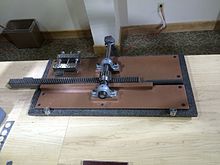
The Castaing machine is a device used to add lettering and decoration to the edge of a coin. Such lettering was necessitated by counterfeiting and edge clipping, which was a common problem resulting from the uneven and irregular hammered coinage. When Aubin Olivier introduced milled coinage to France, he also developed a method of marking the edges with lettering which would make it possible to detect if metal had been shaved from the edge. This method involved using a collar, into which the metal flowed from the pressure of the press. This technique was slower and more costly than later methods. France abandoned milled coinage in favour of hammering in 1585.
England experimented briefly with milled coinage, but it wasn't until Peter Blondeau brought his method of minting coins there in the mid-seventeenth century that such coinage began in earnest in that country. Blondeau also invented a different method of marking the edge, which was, according to him, faster and less costly than the method pioneered by Olivier. Though Blondeau's exact method was secretive, numismatists have asserted that it likely resembled the later device invented by Jean Castaing. Castaing's machine marked the edges by means of two steel rulers, which, when a coinage blank was forced between them, imprinted legends or designs on its edge. Castaing's device found favour in France, and it was eventually adopted in other nations, including Britain and the United States, but it was eventually phased out by mechanised minting techniques.
